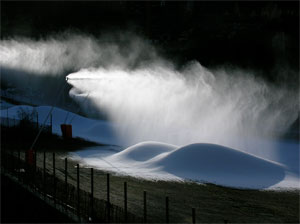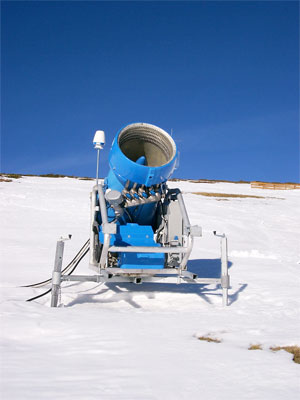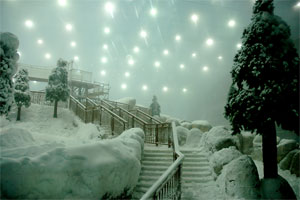In the middle of the 20th century a device was invented that would forever change the way that ski areas operate — the man-made snow machine. Snow sports enthusiasts have long been at the mercy of the weather to give them desired snow conditions. However, ski areas now rely significantly less on the weather to run a profitable operation. Using concepts of thermal physics combined with numerous mechanical devices and IT developments, engineers have further developed the technology to be able to single handedly cover a mountain with snow. The snow made from these machines is not artificial snow, but real snow with crystal structures similar to natural snow. This technology has helped prolong ski seasons as well as helped the entire industry grow.
Introduction
Ever since snow sports have existed, participating athletes have been looking for the runs that exhibit the ideal conditions of a great slope – an entire hillside covered by thick, fluffy snow throughout the winter. For skiers and snowboarders, snow depth has not only played a huge role in the quality of their run, but has also determined whether or not that run would be open. Ever since ski areas were established in the early 20th century, season lengths and customer flow – and thus the entire business of the snow industry – have been dependent on snow conditions. A poor snow fall can easily lead to a ski area failing to make a profit for the season, and because of this, areas have consistently been at the mercy of the weather [1]. Instead of finding ways to control the weather, the skiing and snowboarding industries turned to engineers to come up with a new method to consistently create near perfect slopes on any mountainside: snow-making technology.
The Essence of Snow
Snow is the accumulation of tiny crystals of ice, known to us as snow flakes, which form when natural precipitation freezes in the air. If you have ever been outside during a snow storm and looked closely at each individual snow flake, you would notice they each have an aesthetically pleasing, symmetrical, and crystalline structure. As many snow sports enthusiast know, snow also falls in different forms, such as ‘powder’ or ‘slush’, depending on different weather factors.
The humidity and temperature of the air contribute most to determining which form snow will take when it falls. For example, dry and cold conditions will lead to ‘powder,’ which many consider the most enjoyable type of snow, whereas wet and warm conditions lead to ‘slush.’ In fact, scientists have coined the phrase “wet-bulb temperature” as a measure of the temperature outside combined with humidity, as opposed to the “dry-bulb temperature”, which consists of purely a temperature measurement. Elementary science books tell us water freezes at 32° Fahrenheit, or 0° Celsius, but in reality snow crystals form at different temperatures depending on the humidity level. For example, in low humidity and 37° Fahrenheit, crystallization may take place. On the other hand, in high humidity and at a temperature below 32° Fahrenheit, crystallization may not be possible, demonstrating the value in using wet-bulb temperature (a method of temperature measurement which also takes into consideration relative humidity) as a primary measurement scales for engineers when making snow [2].
Air humidity can also affect the freezing temperature of pure water, a concept that can be explained by basic thermal physics. Energy in thermal physics is measured in calories, where one calorie is the energy needed to raise one gram of water one degree Celsius. Similar to the way that calories are needed or given up to raise or lower the temperature of water, the process of changing liquid water to vapor requires energy, referred to as the latent heat of vaporization. Also, liquid water changing to ice releases energy, called the latent heat of fusion. A high humidity level causes a higher latent heat of vaporization, because more energy is required to create water vapor where a high level already exists. In contrast, in low humidity, water easily evaporates due to the willingness of dry air to accept water vapor and thus has a lower latent heat of vaporization [3].
When water droplets are shot into air that is below the wet-bulb temperature, vaporization as well as freezing occurs. As stated in the Alpine Education Guidebook, “vaporization of water powers the cooling that makes the snow. The latent heat of vaporization [of a portion of the water] carries enough heat away to bridge the latent heat of fusion needs [of the remaining water], and ice is the result” [2]. Since the latent heat of vaporization increases proportionally to humidity, low humidity levels require less energy to freeze a liquid substance such as water, resulting in a higher freezing temperature. The process of making man-made snow follows the law of conservation of energy, which states that the energy given to the liquid to create vapor equals the energy taken from the liquid to create ice (see Fig. 1).
Snow-Making Technology
Snow machines have come a long way since being invented in the 1950s, and continue to improve in efficiency and technology. Initially, machines ground up already frozen ice and sprayed it out – similar to a big snow cone machine with a hose. This method does not have temperature restrictions for snow making, which makes it ideal for situations where snow needs to be made in above-freezing temperatures. However, it is loud, expensive, and inefficient. Thus, two more main types of snow machines have since come into use and continue to evolve today: water/compressed air hoses and snow cannons. While the physical constructions of these systems differ, the engineering technology to efficiently create the best snow overlaps.
Engineers first created the water/compressed air hose as a means of making snow in sub-freezing temperatures. These machines basically shoot a stream of compressed air and water into the atmosphere. If you have been to a ski area, these are the ones that look like a fire hose positioned on a tower. Generally less expensive than snow cannons, water/compressed air hoses are also more mobile. However, they lack the volume that the snow cannons can produce, and are noisy and expensive to operate. The most basic form of this device comes in a single package with a small engine running an air compressor at the base of the device; the water is supplied through hoses at the bottom [4].
Engineers have also created more sophisticated centralized devices, which have a central air compressor (normally between 80 and 100 psi of pressure) and water pump (Guido). These allow for hoses, and thus snow, to be taken anywhere on the mountain.
The most sophisticated and newest snow making technology is the snow cannon. With hundreds of small nozzles spraying streams of water towards the center of a metal barrel, snow cannons propel the snow into the air with a large fan in the back of the system, which is typically run by electricity. However, these systems are significantly larger than the water/compressed air hoses. Also, they cost more than the water/compressed air hoses and are not nearly as mobile. They can, however, provide a significant increase in snow production while running more quietly. In fact, some types can “pump out a foot of snow over 2.1 acres in 12 hours, at 10° F and 60% relative humidity using 400 gallons of water per minute”. Often, these systems will be found at high volume resorts where having a prolonged season is essential to profitability (see Fig. 2).
While the previous two systems have been described in relatively simple terms, both require advanced engineering technology to create life-like snow in all weather conditions. Engineers have to create the perfect mix of water and compressed air, or in the case of the snow cannon, a perfect mix of water output and fan power. More pressure or fan power will shoot the water streams higher in the air, allowing the water particles to disperse more fully and have more time to freeze on the way down, which is needed in high wet-bulb situations. However, in low wet-bulb situations snow makers can afford to shoot the snow with less power, which decreases operation costs [2].
Engineers have also created advanced centralized snow making controls that allow operators to control water/air pressure/fan power from a separate building by taking weather measurements from sensors spread throughout the mountain. These weather measurements can be fed into a computer system that can calculate the ideal ingredient ratio. Complex snow making systems provide a much more efficient way of adjusting the machines than doing it by hand. In addition, operators can control the direction the machines are pointing from a separate remote connected to motors on each machine.
Environmental Considerations
Since many ski areas are situated in protected mountain forests, and because of the large amount of water and power used in snow making, many environmental concerns have been raised about snow making at ski areas. For example, Sunday River in Maine has the ability to convert over 9,000 gallons of water a minute into snow. Large snow-making operations like Sunday River can drop local water supplies to alarming levels. This, in turn, can create severe habitat risks trout, salmon, frogs, turtles, and other smaller organisms vital to the food chain [4]. Nevertheless, engineers, mountain executives, and environmentalists have worked together to create eco-friendly solutions to the water supply problem. Such a solution exists at Okemo Mountain, where a 70-million gallon pond stores water from spring river runoff to counteract the loss of water [5].
Problems also arise from the electricity needed to power the hundreds and sometimes thousands of snow cannons at ski areas, or from the pollution produced from gas air compressors. To cope with these difficulties, engineers have been working towards making snow-making machines more efficient, as well as creating environmentally conscious solutions to the water necessity problem.
Conclusion
Snow-making machines have become an integral part of ski areas since the mid 20th century and have changed the way they operate. The technology behind these machines ranges from mechanical air compressors to complicated computer IT programs. Thanks to technology developed by engineers, ski areas are able to stay open for longer, more consistent seasons (see Fig. 3). Events that would normally prove difficult and costly to reschedule, such as the Winter Olympics, need not wait for proper weather conditions. The technology has also been utilized to create large indoor ski areas in warm climates, such as a 22,500 square meter development in Dubai. In the future engineers will continue to lead the way in snow-making technology and ensure that there will always be a slope to ski down.





